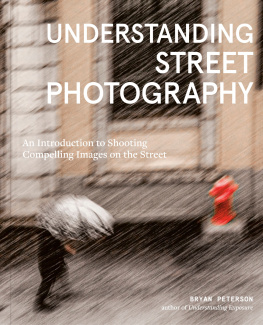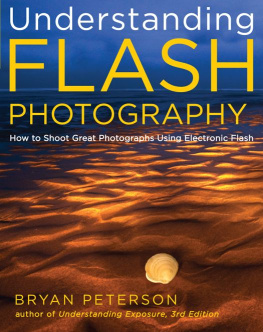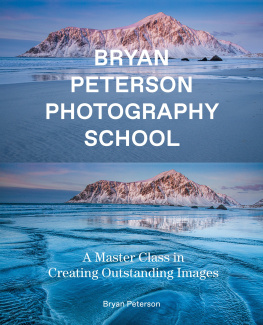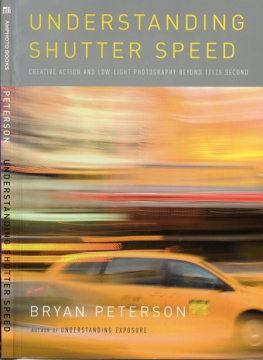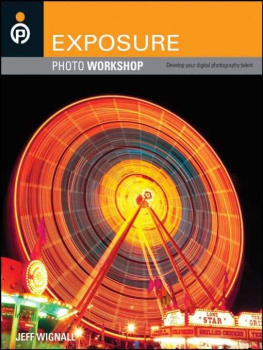

Copyright 1990, 2004, 2010, 2016 by Bryan Peterson
Photographs copyright 2016 by Bryan Peterson
All rights reserved.
Published in the United States by Amphoto Books, an imprint of the Crown Publishing Group, a division of Penguin Random House LLC, New York.
www.crownpublishing.com
www.amphotobooks.com
AMPHOTO BOOKS and the Amphoto Books logo are registered trademarks of Penguin Random House LLC.
Previous editions of this work were published by Amphoto Books, Berkeley, in 1990, 2004, 2010.
Library of Congress Cataloging-in-Publication Data
Peterson, Bryan, 1952- author.
Understanding exposure : how to shoot great photographs with any camera / Bryan Peterson. 4th edition.
pages cm
Includes bibliographical references and index.
1. PhotographyExposure. I. Title.
TR591.P48 2016
771dc23
2015025905
Trade Paperback ISBN:9781607748502
Ebook ISBN9781607748519
v4.1_r1
a
Every photograph is a lie, but within that lie a mountain of truth is revealed! And the climb towards the top of that mountain of truth is greatly accelerated when ones steps are rooted in the simple understanding of exposure.
BRYAN PETERSON

CONTENTS


INTRODUCTION
The year was 1975, but it seems like yesterday that I first introduced the photographic triangle to a group of about forty students. It was on a Saturday, and I was running an all-day workshop on understanding exposure on the campus of Portland Community College as part of a program of continuing adult education. I had never presented to a group this large, and little did I know then that groups of forty students one day would swell toward one thousand attendees. My journey has in many respects been truly humbling.
When I first picked up a camera in the summer of 1970 (a suggestion made by my older brother Bill, who was a keen amateur photographer), my intention was to use the camera as a way to record landscapes and cityscapes. I was an artist and wanted to capture those scenes for later sketching with my inks and charcoals. Little did I know then that the reference photos I took with my brothers camera would send me on a photographic journey that has lasted more than forty-five years. I have had far more adventures, chance encounters, and good fortune than should be legally allowed for a single lifetime. Of course, all of my adventures have not been without some setbacks, unbelievable obstacles, and momentous challenges, but somehow Im still here churning out another edition of Understanding Exposure .
During those first five years, 1970 to 1975, I made it a point to write down every exposure for the reference photographs I took. When I would review each image, I knew which aperture I used and which shutter speed I used and was soon able to determine why one aperture in conjunction with a particular lens would produce a massive depth of field or a very narrow depth of field. I also knew which shutter speeds were capable of creating motion-filled water, windblown flowers and leaves, and razor-sharp action-stopping subjects. I was soon figuring out that in every picture-taking situation, I was presented with no fewer than six possible exposure options and those six exposure situations could easily be changed to a different set of six options merely by changing from one film to the other; an ISO of 50 produces a different set of six possible correct exposure options than does an ISO of 200 or an ISO of 640, and so on.
I soon found myself making a drawing of a triangle in one of my notepads, showing the three ingredients of every correct exposure: aperture, shutter speed, and the ISO. Of course at the heart of the triangle was the light meter, whose job is 100 percent dependent on the photographers ability tell it which aperture or shutter speed he or she is using and how many eyeballs (ISO) he or she wishes to use for a particular scene. I mention all this for one very important reason: I emphatically believe today, just as I did back then, that if you will invest the time needed to understand the vision of the photographic triangle and the many creatively correct exposures it offers, your mind will be truly free to create almost any image it can conceive in camera!
I am all too familiar with the phrase the third times a charm, and I honestly thought that when I finished the third edition of Understanding Exposure , it would be the last edition Id write for one simple reason: I felt I had exhausted the subject of understanding exposure. Obviously I was wrong!
I am incredibly humbled by the response to the earlier editions, with combined sales of more than one million copies in seven different languages. With numbers like that one might ask, Why mess with a winning formula?
To be clear, I am not messing with the winning formula, but since the third edition of Understanding Exposure was released in 2009, even more changes have taken place in the photo industry. The one change I readily welcome is the ease of using an electronic flash. One I dont appreciate as much is the extremely high dynamic range that many cameras are quickly approaching. In a single shot, a few of todays cameras sensors are capable of capturing upward of 9 stops of light to dark exposure, and at this rate a sensor soon will be recording the human eyes ability to see a 16-stop range! This is a huge change from the days of film, when one might expect about a 5-stop range of light to dark. Why is this a problem? In some cases it will mean the end of the many beautiful sidelit landscapes of great contrast in which the strong highlights are in marked opposition to the deep and dense shadows. There will no more of this stark contrast because of the sensors ability to create images that cover a much wider exposure and tonal range.

On the flip side of all this new technology, I am hearing from more and more amateurs who have not only realized the limitations of their camera phones and are buying DSLRs but are also interested in getting it right in camera rather than relying on after-market software to clean up their exposure mistakes. In effect, it seems the trend today is akin to the days of film, when most, if not all, amateur photographers took pride in owning their creativity. They relied solely on their knowledge of the multitude of creative exposures that lie within the photographic triangle and a full understanding of the power of light, including the use of electronic flash. I have seen more evidence of owning ones creativity in the last twelve months than I have seen in the previous five years, and needless to say, I am thrilled. I am not, nor have I ever been, nor will I ever be a fan of automated exposures. And yes, beyond the choice to shoot in any automated camera-setting mode, my disdain for automation includes the use of highly manipulative photo software, with HDR (high dynamic range) being just one example.
Next page


